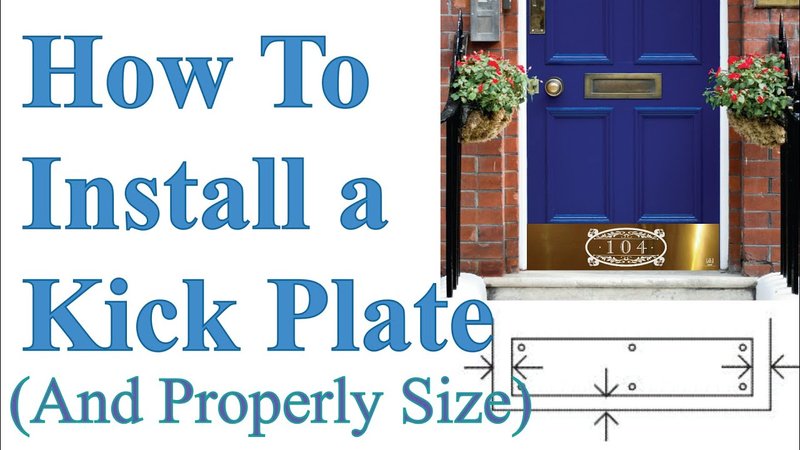
Here’s the thing: matching a kick plate finish to your existing door hardware isn’t just about being picky. Those little choices actually make a huge impact on your home’s first impression. A mismatched finish can stick out like a sore thumb, while a thoughtful match ties everything together. Whether you’re outfitting a classic Schlage handle set or a modern Kwikset deadbolt, the right finish will make your door look intentional, polished, and welcoming.
So, how do you get it right without turning your door into a hodgepodge of mismatched metals? Let me walk you through what really matters—from understanding finishes to ordering with confidence—so you’ll never have to wonder if you got it right.
Why Matching Door Hardware Finishes Matters
Let’s be honest: most people don’t obsess over door details. But once you notice a glaring finish mismatch—say, a bright brass kick plate below an oil-rubbed bronze handle—it’s hard to unsee it. Matching your kick plate finish to your existing door hardware matters for a few reasons beyond just looks.
First, it’s a visual anchor. When all the metal elements work together, your entryway instantly looks more pulled-together and well-designed. Even if your style is eclectic, coordinated finishes make everything feel harmonious. If you’re trying to boost curb appeal or prepping for resale, this is one of those little upgrades that packs a punch.
Second, matching finishes help mask wear and tear over time. Metal ages in its own way, and combining wildly different finishes often makes scuffs and discoloration more noticeable. Keeping everything in the same family helps hide age, so your door hardware looks fresher, longer.
Lastly, there’s the psychology: even if people can’t pinpoint why your entryway feels cohesive, they’ll likely walk away with a better impression. That’s the power of good details—they just *feel* right.
Common Door Hardware Finishes Explained
You might be wondering, “What finish do I even have right now?” If you’re not fluent in hardware-speak, finishes like “antique nickel” or “satin brass” can sound confusing. Let me break down the most common ones you’ll run into, especially among brands like Schlage, Kwikset, and Baldwin.
- Polished Brass: This classic, super-shiny gold finish is warm and traditional. You’ll find it in older homes or on doors aiming for a vintage vibe.
- Satin Nickel: A soft, silvery look that’s matte (not shiny). Satin nickel is everywhere right now—modern, understated, and versatile.
- Oil-Rubbed Bronze: Dark brown, almost black, with subtle copper highlights that peek through. This finish is popular for a cozy, old-world feel.
- Matte Black: A bold, flat black. Super contemporary and great for making a statement or contrasting lighter door colors.
- Satin Chrome: Silky, cool-toned silver with a sleek look—less yellow than nickel, more modern than polished chrome.
Why does the exact finish matter? Even small differences—like the warmth of brass or the sheen of nickel—can make or break the match. Some brands have their own take (Schlage’s “Aged Bronze” looks different from Kwikset’s), so check your current brand or look for photos online to be sure.
How To Identify Your Existing Door Hardware Finish
Finding the finish on your current door hardware isn’t always as easy as it sounds—especially if your home is a few years old or you’ve inherited a mixed bag. Here’s how you can decode what you have without guesswork.
Check for Manufacturer Stamps or Labels
Start by looking for any branding on your door hardware. Big-name brands like Schlage and Kwikset usually stamp their names somewhere (often on the inside edge of the door, the plate, or even under the latch). Knowing the brand makes finish matching much simpler, since each company has a set of standard finishes.
Compare in Good Lighting
Natural daylight is your friend. Take a close-up look at your hardware and note the color undertones. Is it more yellow (brass), cool silvery (chrome or nickel), or deep brown (bronze)? Snap a photo with your phone and hold it next to finish samples online or in-store.
Bring a Removable Piece for Reference
If you’re planning to shop in person, unscrewing a hinge or strike plate and bringing it with you can save a lot of guesswork. Hardware stores are used to this move, and it makes matching almost foolproof.
Still Not Sure?
If you’re struggling to narrow it down, look up your home’s builder or reach out to a local locksmith. They often know the default hardware for your neighborhood. Or, try searching your door hardware’s model number—which could be stamped inside the edge—for direct finish details.
Should You Match Exactly, Coordinate, or Mix Finishes?
You might be wondering if you *have* to match your kick plate finish to your door hardware exactly. Here’s where things get a little philosophical—and a bit fun. There are three main approaches: match, coordinate, or intentionally mix.
Exact Match:
This is the no-brainer route. If your lockset is satin nickel, you choose a satin nickel kick plate. Everything blends, and your entryway looks seamless. This works well for most homes and removes the guesswork.
Coordinate Within a Color Family:
Sometimes, an exact match isn’t possible—maybe your brand’s finish is discontinued or you want to update things slowly. Coordinating works just as well. For example, mixing satin nickel with chrome can look intentional if the tones are similar. Brass and gold hues also play nicely together if they’re both matte or both polished.
Mix Finishes (If Done Right):
Mixing takes guts, but it can pay off if you know the rules. Designers often mix black hardware with brass accents for a modern look, or pair antique bronze with polished nickel for vintage charm. The trick? Limit to two finishes and repeat each at least twice, so it feels deliberate—not random.
When in doubt, match. But if you love a bit of rebellion, coordinate or mix carefully for a designer look.
How To Order the Right Kick Plate Finish
Ready to buy? Don’t let the sheer number of finish choices overwhelm you. Here’s how to order the right kick plate finish, especially if you’re matching to brands like Schlage or Kwikset.
Confirm Size and Drilling
Kick plates come in different lengths and heights. Measure your door carefully and note how yours attaches (screws, adhesive, or magnetic). Most standard exterior doors use 6-inch or 8-inch tall kick plates.
Use the Exact Finish Name
If you know your hardware brand, look up their finish chart online. For Schlage, you might see names like “Antique Brass” or “Satin Nickel.” Kwikset might call it “Venetian Bronze” or “Polished Chrome.”
Use these exact words when searching or ordering, and always double-check product photos.
Ask for Samples if Possible
Shopping online? Request a sample or order from a retailer with a good return policy. Colors can look different in person than on a screen.
Double-Check Special Finishes
Some brands offer “living finishes” (like oil-rubbed bronze) that change color over time. If you have one of these, it’s smart to order a kick plate in the same material—even if it’s a shade off now, they’ll patina together with use.
What To Do If You Can’t Find a Perfect Match
Here’s where things get tricky. Maybe your door hardware is old, discontinued, or just stubbornly unique. What then? Don’t panic—there are workarounds.
Custom Order a Kick Plate
Many hardware companies offer custom color matching for an extra fee. It might take a bit longer, but you’ll get a finish as close as possible to your hardware. Great for historic homes or serious perfectionists.
Opt for a Neutral or Contrasting Finish
If matching just isn’t happening, choose a true neutral: matte black, satin stainless, or antique bronze. These finishes have a way of blending in or creating a tasteful contrast. Sometimes, a bold black kick plate on a white door looks sharper than an awkward half-match.
Consider Removing or Replacing All Hardware
If your hardware is badly mismatched or in rough shape, it might be time for a full hardware refresh. Swapping out handles, deadbolts, and plates for a matching set takes more work up front, but the payoff is a door that looks new and coordinated—especially important for front doors.
Tips for Maintaining Your Kick Plate and Hardware Finish
Once you’ve picked the right finish, keeping it looking good is the next step. Here’s how to avoid scuffs, tarnish, or color changes—especially on high-touch metals like those from Schlage or Baldwin.
Clean Gently and Regularly
Wipe down your kick plate and door hardware every few weeks with a damp cloth. Avoid harsh cleaners or anything abrasive, which can scratch or dull the finish.
Use a Mild Soap Solution for Tough Spots
If there are stubborn marks (like shoe scuffs), mix a little dish soap with warm water. Dip a soft cloth in, wipe, then immediately dry the finish with another cloth. This works well for satin nickel, brass, and most painted finishes.
Protect Against Weather and Salt
If you live in a rainy or coastal area, hardware finishes can take a beating. Consider applying a thin coat of car wax (yes, really) to seal and protect both the hardware and kick plate. Reapply every few months.
Watch for Signs of Wear
“Living finishes” like oil-rubbed bronze will naturally develop a patina as you use them. If you love the look, let it age. If not, rub gently with a little mineral oil to restore some shine—or talk to the manufacturer about special touch-up pens.
Small Details, Big Impact: Wrapping It Up
Matching a kick plate finish to your existing door hardware might feel like overkill, but those little details can completely change how your entryway looks and feels. Once you know what finish you have—whether it’s Schlage’s aged bronze or a classic Kwikset satin nickel—finding (or coordinating) the right kick plate becomes a whole lot easier.
Take it slow, compare samples, and don’t be afraid to ask for help. Even if you end up mixing finishes, do it with confidence and intention. After all, your front door is the first handshake your home gives to the world—make sure it’s saying exactly what you want it to.
And honestly, if you’re ever in doubt, matching the kick plate to your existing door hardware is always a safe bet. You’ll walk away happy, and your entryway will look spot-on every time.
